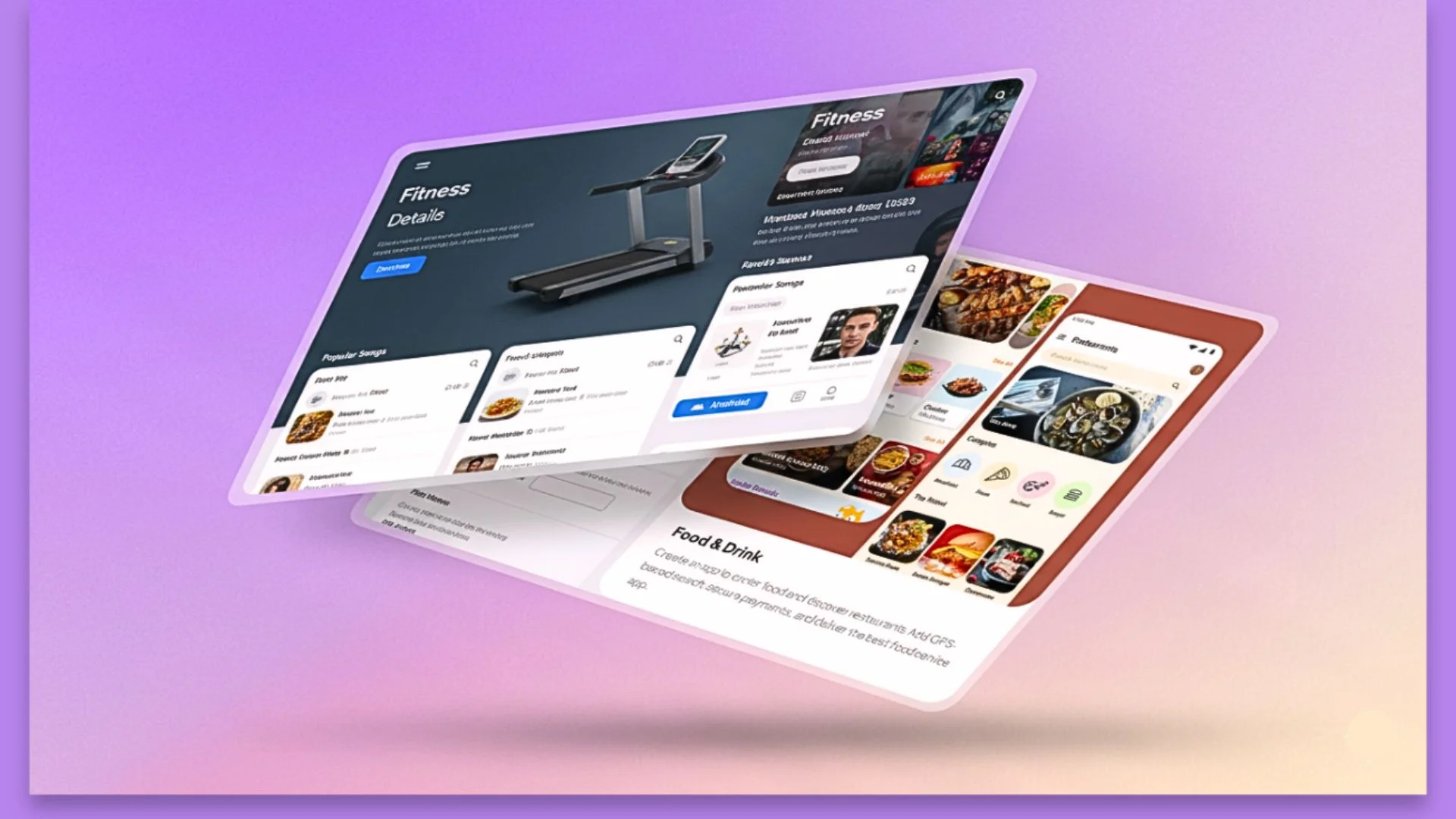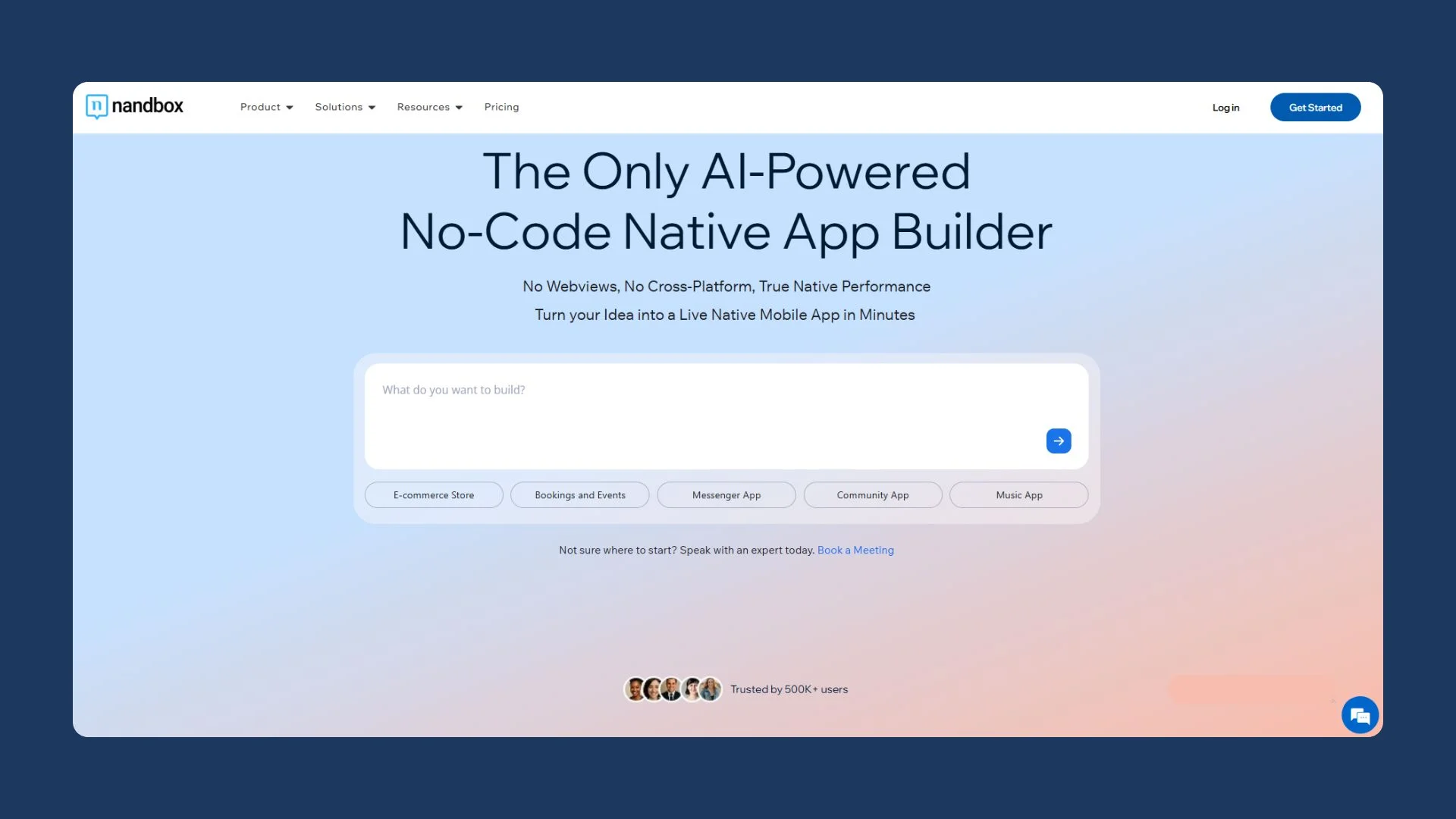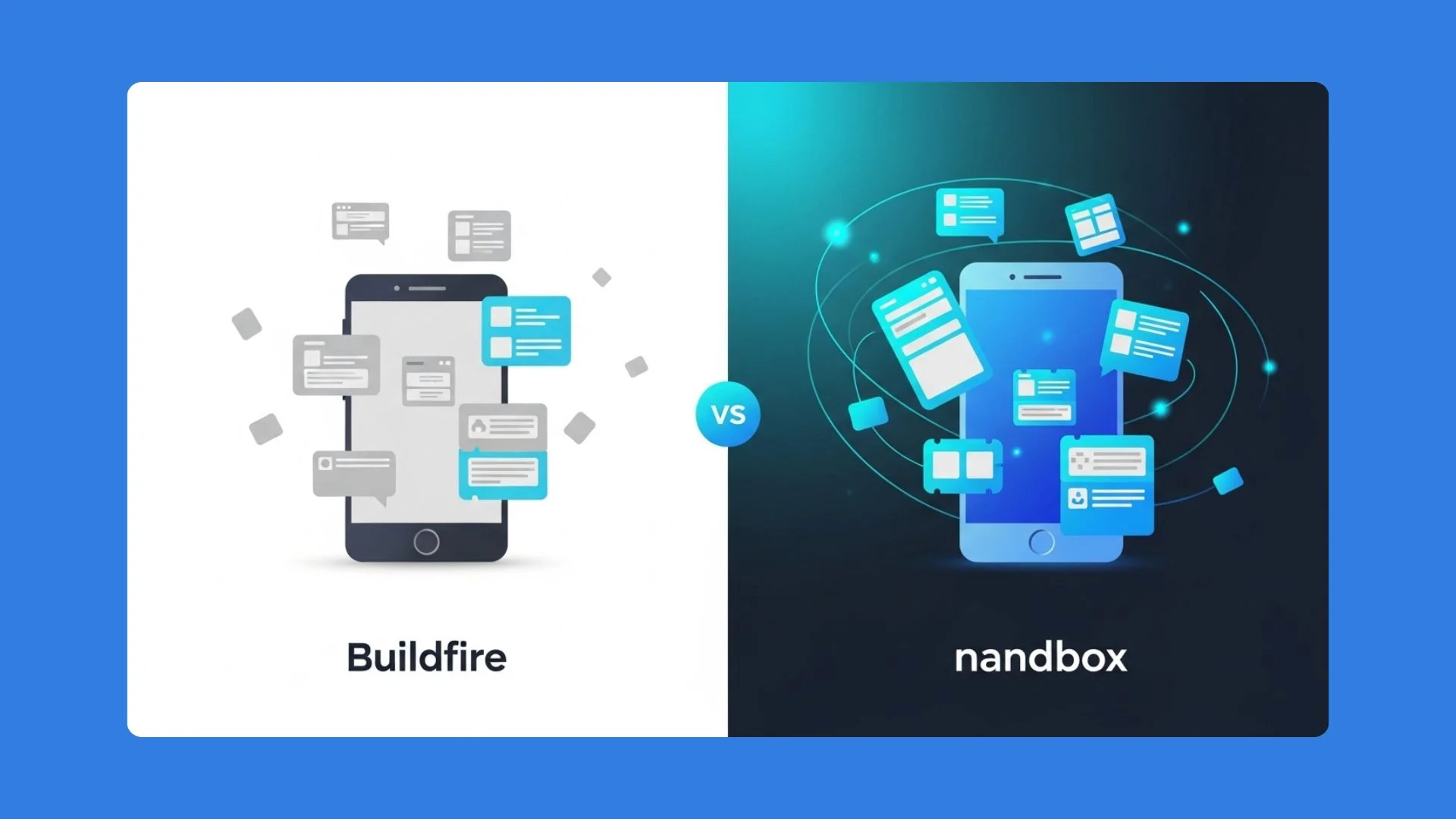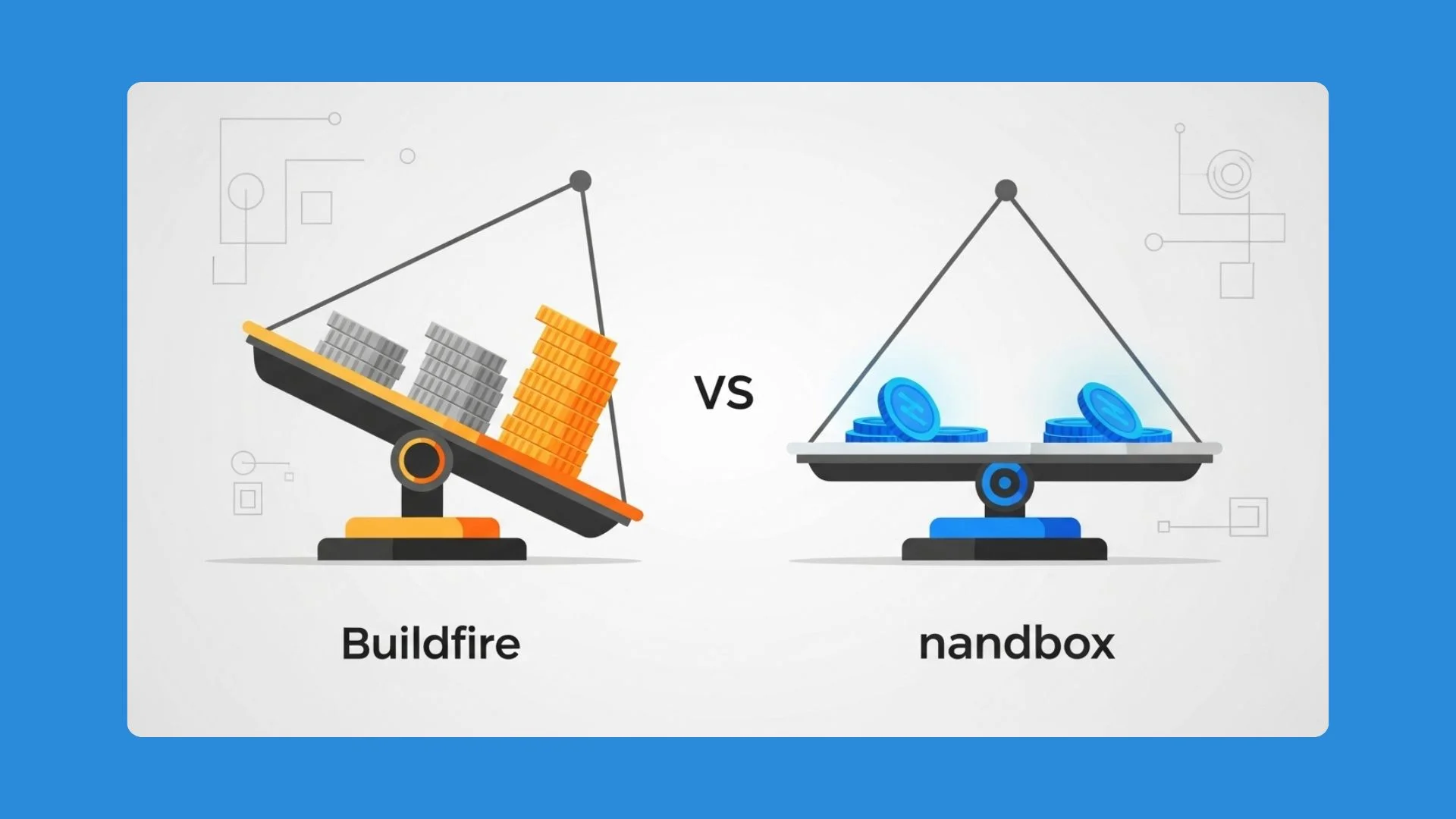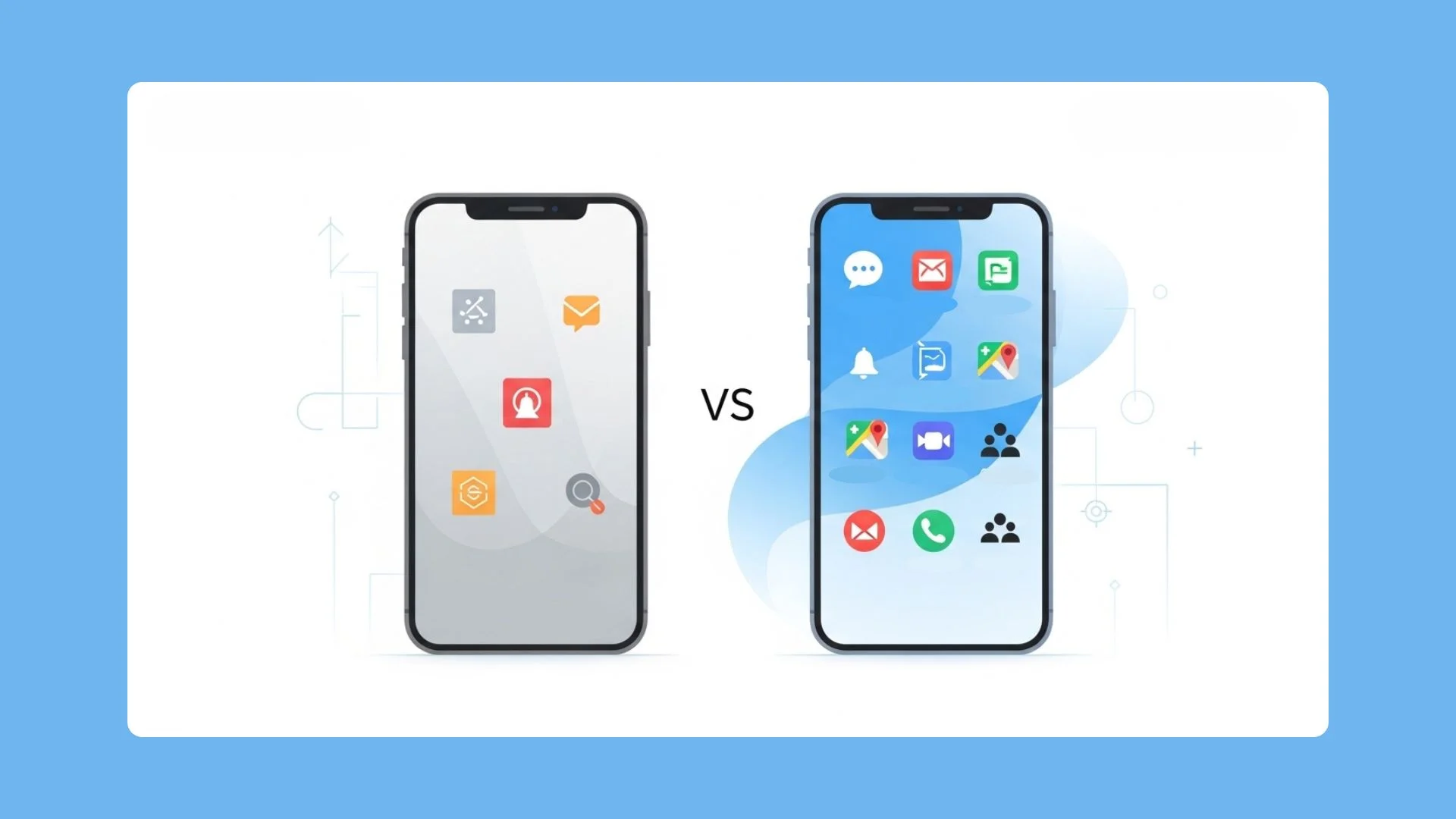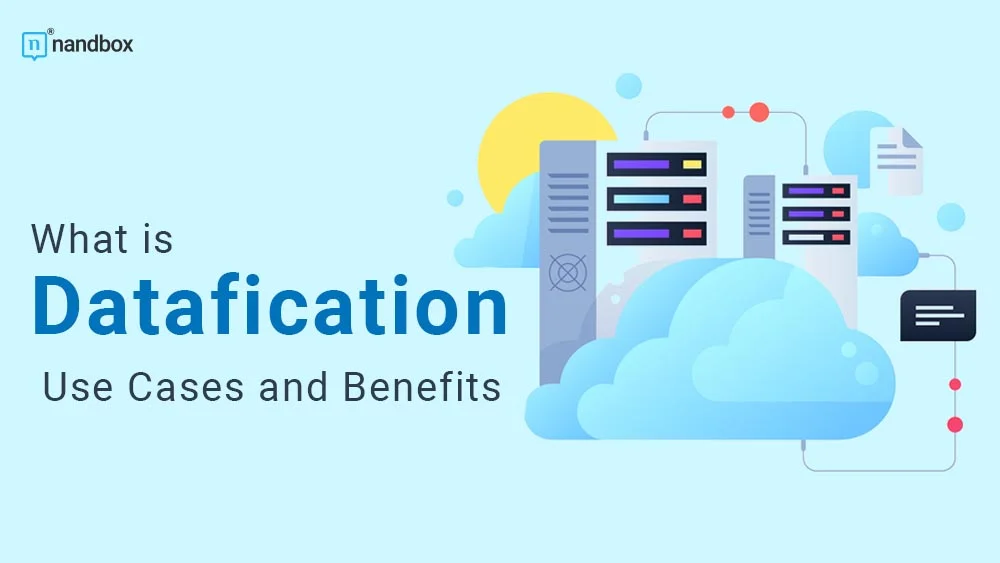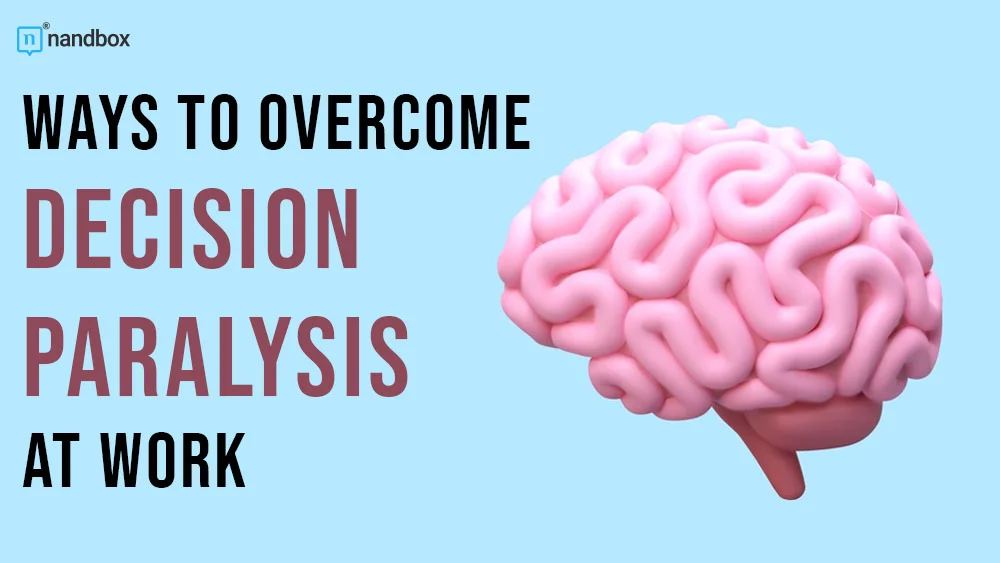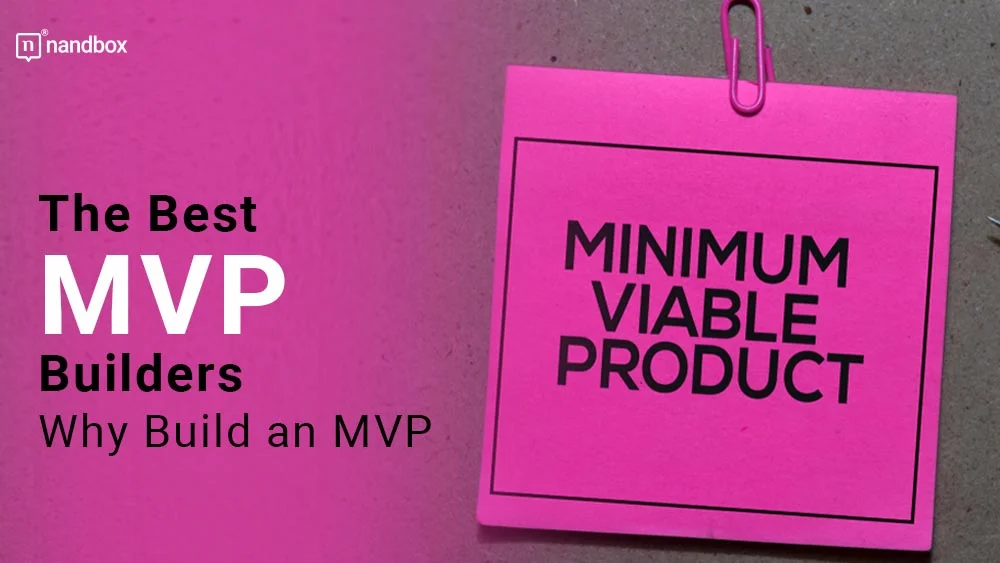Key Takeaways
- Both nandbox and Buildfire are popular no-code app builders, but they take completely different approaches to app creation.
- nandbox is a true native app builder that lets you create high-performance iOS and Android apps with 100+ built-in features, while Buildfire relies heavily on third-party plugins from its marketplace to add most functionalities.
- When it comes to speed, scalability, and reliability, nandbox offers a fully native infrastructure with faster performance, offline access, and enterprise-grade security. Buildfire apps, on the other hand, depend on plugin-based integrations that can affect stability and increase maintenance costs.
- nandbox is ideal for creators and businesses who want an all-in-one platform with in-app chat, group messaging, bookings, payments, and AI-powered tools, all built-in and ready to use. Buildfire works better for simpler apps or teams that prefer to customize through external plugins.
- In terms of AI and automation, nandbox leads with an AI-powered app builder that generates complete native apps in minutes, while Buildfire offers a manual drag-and-drop model as well as an AI-powered assistant.
- On pricing and value, Buildfire offers custom plans that can get expensive as you scale, whereas nandbox provides affordable all-inclusive plans with unlimited push notifications, dedicated support, and no extra plugin fees.
- Overall, Buildfire is suitable for basic prototypes or organizations comfortable managing third-party plugins, while nandbox is the stronger choice for scalable, high-performance native apps built without coding.
nandbox vs. Buildfire: Which No-Code App Builder is the Best?
You finally built your app. It looks great, until users start complaining about lag, missing features, and “something broke again.” Suddenly, you’re buried under plugin updates, hidden costs, and endless support fees. Sound familiar? That’s the dark side of many no-code app builders.
But here’s the thing: Not all no-code app builders are built the same. That’s why choosing the right no-code app maker matters from day one.
Both nandbox and Buildfire promise to help anyone build an app without coding, but the way they do it and the results you get are completely different. One builds hybrid web-based apps, leans heavily on plugins and third-party integrations, while the other builds true native iOS and Android apps with everything built in and ready to scale with the best performance, speed, and security.
So the question is: Which no-code app builder is the best in 2025, nandbox vs. Buildfire?
We tested both platforms hands-on to see which one actually delivers the best experience, functionality, reliability, and performance for users who want to build an app without coding.
So in this article, I will guide you through how to choose the best no-code app maker and compare the top app builders: nandbox vs. Buildfire across multiple factors, including:
- Native vs. hybrid
- App performance, security, and offline access
- Pricing and subscriptions
- AI-powered app generation and AI capabilities
- Design, branding, and customization
- App functionality and features
By the end, you’ll know exactly which no-code app builder actually helps you build faster, launch smoother, and scale without rebuilds or hidden limits, based on real hands-on testing, not just hype.
Platform Overview: Which No-Code App Builder Is Better, nandbox vs. Buildfire?
If you have been searching for a way to build an app without coding, then you’ve probably come across nandbox and Buildfire. Both nandbox and Buildfire are among the best no-code app builders, but they take very different approaches to help you create your app without coding.
Buildfire focuses on hybrid apps, plugins, and web-view technology. On the other hand, nandbox builds true native iOS and Android apps that deliver the best performance, security, and scalability. This native vs. hybrid difference mainly affects everything else.
So let’s discover how nandbox vs. Buildfire compares in terms of app type, performance, security, offline support, and scalability.
| Feature | nandbox | Buildfire |
| No-code/Low-code | 100% No-code app builder | No-code/low-code app builder (Developer SDK) |
| App Type | True native iOS and Android app builder | Hybrid Apps builder |
| App and Web Support | iOS and Android native apps | iOS, Android apps, and PWAs |
| App Performance | Faster speed, performance, and seamless user experience | Slower speed and lower performance (depends on web-view performance) |
| App Security | More secure: Native-level encryption and isolated app architecture | Less secure: Web-based structure with limited security |
| Offline Access | Full offline support: Users can access all app features and data without an internet connection | Limited: Only available through certain plugins, while most features still require an internet connection |
| Global Architecture and Scalability | Enterprise-grade architecture: High-throughput platform with a distributed backend built to perform at large scale | Plugin-based architecture: Works well for smaller apps, but may require custom code for high scale |
| Best For | Mostly all: beginners, startups, small and mid-sized businesses, enterprises, and anyone who wants to build apps without coding | Startups, MVPs, and simple app ideas |
After testing both platforms, this nandbox vs. Buildfire comparison shows that Buildfire is great for testing new ideas or creating simple apps, while nandbox is built for those who want to create fully native apps with faster performance, stronger security, greater scalability, and even full offline access support, all without writing a single line of code.
Moreover, nandbox is built for enterprise-grade performance, which means your app can easily handle thousands of users at once without slowing down. Its backend runs on a globally distributed architecture, cached across multiple data centers to keep your app fast and stable anywhere in the world. On the other hand, buildfire depends on web-view technology, which can affect loading times and reliability when your app starts to grow and scale.
Pricing Plans: Which No-Code App Builder Is More Affordable, nandbox vs. Buildfire?
Let’s be honest, pricing can make or break your decision when choosing a no-code app builder. Pricing doesn’t just mean the cost you pay each month; it’s more about the value you get in return.
After reviewing and testing the pricing plans of both platforms, we found that both nandbox and Buildfire offer flexible plans for those who want to build apps without coding. However, they differ greatly in pricing and overall value. nandbox offers both lower prices and higher value, as well as advanced native app features. Buildfire, on the other hand, comes at a higher cost, and many of its key features and support are limited to higher-tier plans.
Let’s compare nandbox vs. Buildfire in terms of pricing, free trial, support, and overall value.
| Feature | nandbox | Buildfire |
| Free Trial | Available | Available |
| Free Trial Period | 7 days | 30 days |
| Credit Card Required | No | No |
| Starting Plan | $59/month | $209 |
| Middle Plan | $159/month | $389 |
| Highest Plan | $359/month | $549 |
| Support | Premium support and professional services via emails and online meetings for all plans | Tiered support with standard customer support on lower plans and account managers, and dedicated support on higher plans |
| Special Plans | Available | Available |
| Special Offers | All plans are for $19.99 for the first month | Not Available |
This nandbox vs. Buildfire pricing comparison shows that nandbox delivers more value. nandbox offers lower pricing and affordable plans while still offering native app performance, advanced features, and premium support for all plans. Buildfire does offer flexible pricing plans, but they come at higher prices with limited features and support in lower plans. This makes nandbox a more cost-effective and affordable no-code app builder for anyone who wants to create apps without coding.
App Design: Which No-Code App Builder Offers More Design Flexibility, nandbox vs. Buildfire?
Design plays a huge role when it comes to building your app without coding. Both nandbox and Buildfire offer design customization, but the real difference shows when you actually start creating your app.
Here’s what we found after testing both platforms’ design and customization features. Buildfire offers basic design tools like a drag-and-drop interface and pre-made templates. On the other hand, nandbox offers advanced app design and customization with AI-powered branding tools and built-in material design that follows both Google Material Design guidelines and Apple Human Interface guidelines.
Let’s find out how nandbox vs. Buildfire compare when it comes to design flexibility, templates, AI capabilities, and overall customization options.
| Feature | nandbox | Buildfire |
| Drag-and-Drop App Builder | Available | Available |
| Pre-Made App Templates | Available | Available |
| App Templates Variety | High, with 60+ industry-specific app templates covering music, e-commerce, communication, booking, education, and more | Moderate, including e-commerce, community, and booking app templates |
| M3 Design Support | Available, follows the latest Google’s Material Design (M2 & M3) and Apple’s Human Interface Guidelines | Not Available |
| Light and Dark Mode Support | Available: Built-in light and dark modes with a toggle switch that meet accessibility contrast guidelines for both iOS and Android | Partially available: Through SDK and plugins (not built-in) |
| App Simulator | Available: Real-time visual app simulator to see app changes during building with theme switching (light/dark) | Available: Visual mobile preview panel to see changes during building |
| Automatic App Branding and Theme Customization | Available: Generate full app branding using logo and brand palette | Not available: Users manually choose colors from preset themes or customize each element individually |
| Splash Screen Customization | High: Users can choose from 7 customizable splash screen templates and customize colors, text, images, and buttons. | Limited: Users manually upload a single static image as the splash screen |
| AI-Powered Photo Generation | Available: Supports AI photo generation for icons and in-app images | Not Available |
| AI-Branding Customization | Available: Auto-generates app color themes, layouts, and icons based on the user’s input | Partially available: suggests app layout and structure |
After testing both platforms, we found out that nandbox provides a more advanced design experience compared to Buildfire, as it offers AI-powered branding, Material Design support, and real-time customization tools. This nandbox vs. Buildfire comparison shows that nandbox is the better choice for users who want to build a mobile app without coding while maintaining full design flexibility and a professional look.
AI-Powered App Generation: Which No-Code App Builder Offers the Best AI App Generation, nandbox vs. Buildfire?
AI has become one of the biggest trends in app building, and for a good reason, as it saves time, effort, and makes the whole app-building process easier even for beginners. Both nandbox and Buildfire offer AI tools to help you build an app without coding, but they don’t exactly work the same way.
We tested both platforms hands-on to see which one actually delivers real AI-powered app generation and automation features, not just basic suggestions.
After thorough testing, we found that Buildfire uses AI mainly for layout and feature suggestions, while nandbox takes it to another level with full AI app generation, AI branding, and ChatGPT integration, which helps you build fully native apps faster than ever.
So let’s compare nandbox vs. Buildfire in terms of AI app generation, branding, and automation features.
| AI Features | nandbox | Buildfire |
| AI App Generation (Idea to App) | Available: nandbox is the only AI app builder that transforms ideas into ready-to-launch native apps. | Partially available, it suggests features, layouts, and app structure, but doesn’t generate ready-to-launch apps. |
| ChatGPT App Generation | Available: nandbox App Builder GPT transforms ideas into ready-to-launch native apps. | Not Available |
| ChatGPT Integration | Available through API integrations, which let you add ChatGPT AI features like chatbots, translations, and AI workflows to your app | Possible via plugin SDK, but not a built-in feature |
| AI Assistant | Available: Provides a guided walkthrough of the app builder and explains each feature and section | Available, it suggests features, layout, and app structure. |
| AI Feature Recommendations | Available: Suggests features, components, and modules automatically based on app type | Available: Suggests features based on app type |
| AI Content and Photo Generation | Available: AI-powered photo and content generation for app icons, layouts, and in-app images | Not Available |
| AI Branding and Design | Available: AI generates app branding, layout, and design using your logo and brand colors | Available: Suggests initial layout and design with a ”Remiagine” feature |
| Other AI Capabilities | Available: Extracts app colors from logos, builds full branding themes and designs, and automates workflows | Not Available |
After testing both platforms, we found that nandbox offers a complete AI-powered app-building experience, including full-featured app generation, with app branding and automation, while Buildfire’s AI tools are limited to layout and feature suggestions. This makes nandbox the stronger choice for users who want true AI app generation and smarter no-code development.
App Functionality: Which No-Code App Builder Has More Built-In Features, nandbox vs. Buildfire?
Now that we have covered design and AI features, let’s compare nandbox vs. Buildfire in terms of app features and functionality. Both platforms help you create mobile apps without coding, but the type of features, scalability, and integrations they offer are completely different.
During our testing, we found that Buildfire depends mainly on third-party plugins from its marketplace to add most of the features, which can limit performance and flexibility. nandbox, on the other hand, offers more than 100 built-in native app features, including in-app chats, group messaging, bookings, payments, push notifications, and much more, all ready to use in your app.
So if you’re wondering which no-code app builder offers the best built-in functionality, scalability, and native performance, here’s how nandbox vs. Buildfire compare side by side.
| App Functionality | nandbox | Buildfire |
| Built-in App Features | +100 Built-in and ready-to-use native app features | Plugin-based through the Buildfire marketplace |
| In-App Chats and Messaging | Available: Native all-in-one messenger with end-to-end encrypted chats | Available: Chat plugin for one-on-one messaging |
| Group Chats | Available: Large group chats that can hold up to 50,000 users | Not Available |
| Voice Calls | Available: High-quality voice calls using built-in native VoIP functionality | Not Available |
| Video Calls | Available: High-quality video calls using built-in native VoIP functionality | Not Available |
| Push Notifications | Available: Unlimited push notifications for all plans | Available: Limited push notification based on the selected pricing plan |
| Bookings and Appointments | Available: Built-in booking system with calendar integration | Available: Through a booking plugin that can be added to the app through the Buildfire marketplace |
| Built-in Payments | Available: Offers secure payments, including credit cards, debit cards, Stripe, and PayPal | Available: Offers Stripe integration |
| Maps and Location Services | Available: Built-in Maps with GPS integration | Available: Through the Places plugin |
| Multilingual Support | Available: Built-in multiple language support, including English, German, Spanish, French, Italian, Portuguese, and Chinese | Partially available: Manual setup through SDKs and plugins |
| API Integrations | Available: For all plans | Available: Only for higher-tier plans |
| Custom SDKs Support | Available: Developer-friendly SDKs for Java, JavaScript, and Python that can be integrated quickly with existing systems and workflows | Available: Plugin marketplace and SDKs support for custom features |
After testing both platforms, this nandbox vs. Buildfire comparison clearly shows that nandbox provides far more built-in native app features, stronger scalability, and better performance, while Buildfire relies on external plugins that can limit flexibility and speed. If you’re looking for a no-code app builder that delivers everything built in, nandbox is the stronger, more reliable choice.
Final Thoughts: Which No-Code App Builder Is Better, nandbox vs. Buildfire?
As we reach the end of our article, you’re probably asking: Which no-code app builder is better, nandbox vs. Buildfire? The answer to that really depends on what kind of app you want to build and how advanced and professional you want it to be. If you just need a simple prototype or a basic hybrid app, Buildfire can get you started. But if you’re looking for a powerful, fully native iOS and Android mobile app that performs like the giant apps, nandbox is your go-to solution.
After testing both platforms thoroughly, nandbox proved to be faster and more scalable. Moreover, nandbox even offers 100+ built-in features, including chats, bookings, payments, and push notifications, all ready to use without coding or extra plugins. Plus, with nandbox AI-powered app generation and true native iOS and Android support, you can turn any app idea into a fully functioning app in just a few minutes.
So, if you’re asking, “Which no-code app builder is best for creating a native mobile app in 2025?” or “How can I build an app without coding?” the answer is nandbox.
nandbox no-code native app builder is the only app builder that lets you design, launch, and scale fully native mobile apps with AI-powered features, advanced security, and full offline access, all without writing a single line of code. So what are you waiting for? Sign up for your free trial and start building your dream iOS and Android app today!
FAQs: How to Choose the Best No-Code App Builder, nandbox vs. Buildfire?
How can I build an app without coding?
You can build an app without coding using no-code app creators like nandbox. nandbox lets you create native iOS and Android apps in just minutes using a drag-and-drop interface, pre-made app templates, ready-to-use features, and AI-powered app generation.
How do I choose the best no-code app builder?
First, define your app’s purpose, features, and audience. Then compare platforms based on what type of apps they build (native vs. hybrid), pricing, design flexibility, and AI support. For example, nandbox is ideal if you want a native, scalable, AI-powered app builder for both iOS and Android.
How do I publish my app on the App Store and Google Play without Coding?
No-code app makers like nandbox handle publishing for you. Once your app is built, you can use your Apple Developer and Google Play Console accounts to publish directly, all from within the platform without any coding required.
How much does it cost to build an app without coding?
No-code app creators typically offer subscription-based plans that range from $30 to $300 per month, depending on features and usage. With nandbox no-code app builder, you can create your app for less than $100. nandbox provides transparent pricing with no hidden fees, plus a 7-day free trial to help you test the platform before committing.
Does Buildfire offer native app performance like nandbox?
Not exactly. Buildfire apps are web-based, hybrid apps that depend on plugins, which can affect speed and offline functionality. nandbox, on the other hand, builds fully native Android and iOS apps that perform faster, run smoother, and scale better over time.
Is Buildfire good for building mobile apps?
Buildfire is a decent option if you’re creating simple apps or MVPs, but it mainly builds web-based apps that depend on plugins. This can limit performance, offline access, and flexibility. If you want to build true native apps for iOS and Android that run faster and scale better, nandbox is a stronger choice.
What are the limitations of Buildfire?
Buildfire apps rely heavily on third-party plugins to add most of their functionality. This can lead to higher costs, slower performance, and dependency on external updates. nandbox, in contrast, includes more than 100 built-in native features ready to use with no plugins or integrations needed.
Does Buildfire offer AI app generation?
Not yet. Buildfire still relies on manual app creation through its dashboard. nandbox, however, includes an AI-powered app builder that can turn your idea into a complete, ready-to-launch native app, including design, features, and branding in just minutes.
